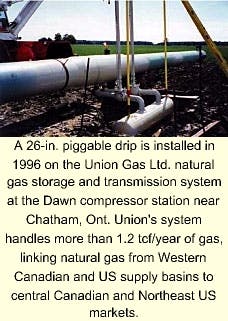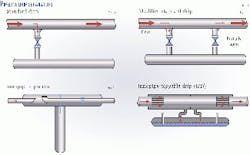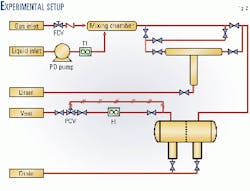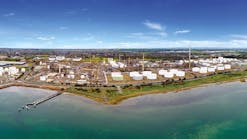A 26-in. piggable drip is installed in 1996 on the Union Gas Ltd. natural gas storage and transmission system at the Dawn compressor station near Chatham, Ont. Union's system handles more than 1.2 tcf/year of gas, linking natural gas from Western Canadian and US supply basins to central Canadian and Northeast US markets.
Canadian gas-plant tests of a new design for in-line gas pipeline liquid separators ("drips") have shown that efficiency of free liquid separation in a pipeline can be increased by a factor of close to ten.
The newly developed drip also allows passage of pipeline inspection gauges (PIG) while working at higher separation efficiency.
Drips are commonly used to separate free liquid in natural gas transmission pipelines. A limitation of available current drips is that, in order to allow free passage of pipeline inspection and cleaning pigs, the drips are not designed to reduce the velocity of the gas as in scrubbers or separators.
And drips have not been efficient at the high gas flow rates (annular flow) experienced by most gas pipelines.
The field test program investigated performances of common drips as well as the recently developed one.
Threat to operations
Liquid may form during transportation of natural gas in pipelines due to pressure loss, temperature change, or retrograde condensation of heavier hydrocarbons in the gas phase.
Compressor or delivery stations should be protected against the liquid because large quantities may interrupt process operations.
Typically, free liquids are separated from a gas stream by a well stream separator that must ensure that the gas and liquid flow rates are low enough to permit gravity segregation.
For gas transmission pipelines, conventional separators are impractical because they require gas-velocity reduction by use of a substantially larger vessel than the pipeline diameter. A pipeline drip is a relatively inexpensive method of removing liquids for pipelines in which pigging is a requirement.
The design of most conventional drips is based on the concept of liquid flow to a pipe branch. Liquid flow into pipe branches results from the centrifugal action of gas stream flowing into the branch.1 2 How much liquid flows into a branch depends on the flow regime and branch orientation among other factors.
One study showed that under a stratified flow regime, no liquid enters the branch for less than 20% gas flow into the branch. In case of more than 35% gas flow to the branch, practically all of the liquid will flow to the branch.3
Under annular flow conditions, liquid flows as a film inside the pipe and some of the liquid is atomized to the core section. As a result, the liquid stream tends to divide itself proportionally into the two directions of the branch.
Further studies confirmed these observations and showed that, in annular flow, increasing liquid flow rate decreases the fraction of liquid removed for a given gas take off.4-6
It was also found that decreasing the pipe diameter increases liquid flow to the branch due to an increase in the thickness of the liquid film traveling along the pipe wall. Orientation of the branch in the pipe only af fects the liquid split if there is stratified flow in the pipe leading to the junction.7
In annular or semiannular flow regime, orientation of the branch has little effect on the liquid split.
An AGA pipeline research committee gathered data from various natural gas transmission companies and concluded that most were experiencing annular flow in their pipelines.8 Most in-line separators fail to separate enough liquid under annular flow; the ones designed to work under annular flow prevent passage of pipeline pigs.
The goal of this project was to evaluate the performance of industry standard in-line piggable separators under annular flow and to compare the efficiency of these drips with a newly developed drip, the Innopipe Piggable Drip (IPD).
The performance of these piggable drips was also compared with an unpiggable in-line separator, the Innopipe Separator.
Drip designs
In a standard drip (Fig. 1a), only liquid traveling at the bottom of the pipe can be removed.
Liquid is separated by gravity, and there is no gas flow to the branch. The advantage of this drip is that it is both piggable and easy to install and operate.
Fig. 1b shows modified standard drip that works like a standard drip except for a small secondary gas flow to the branch, which increases liquid flow to the branch due to centrifugal action of the flowing gas.
The Innopipe Separator (Fig. 1c) is an unpiggable drip that is particularly designed to stop flowing of liquid slugs along the pipeline. This design utilizes the cleansing action of annular flow separation with minimum pipe diameter.
The IPD (Fig. 1d) utilizes a patented process in which an annular gas stream separation technique is used to remove most of the liquid with the least amount of gas at all gas velocities.9 It has two parts: a flow separator and a collection reservoir.
The flow separator consists of a pipe the same size as the natural gas pipeline surrounded by a shell to form an annular chamber. The annular chamber is divided into two halves by a pressure-tight baffle with inlet-outlet flow through slotted apertures. The slots are barred to provide support for pigging tools.
At the inlet to the flow separator, the natural gas stream is separated into two streams: A primary flow continues down the internal pipe of the separator; a secondary flow of gas containing the liquid is drawn into the annular chamber.
This secondary gas stream flow rate can be designed to range from 1% to 10% or more of the primary flow and is directed to a collection reservoir where final separation occurs. The gas is recombined with the main stream at the downstream slotted aperture.
The secondary flow through the reservoir piping is maintained by the low-pressure venturi created by the primary gas flow at the downstream edge of the aperture. The remainder of the primary gas stream that is inherently liquid free (except for the atomized liquid in the middle core) passes through the drip.
The IPD uses the Oranje principal initially to separate the flowing liquids from the pipeline.3 Instead of a branch connection into which 20-35% of the gas stream must flow to remove the liquids, the annular space requires only 1-10% of the gas to remove all of the liquids.
In effect, the annular chamber acts as a branch connection that completely surrounds the pipe. The distinct advantage of annular flow separation is that only a relatively small secondary flow is required and most of the free liquid in a gas stream is removed.
This allows IPD to maintain a high separation efficiency even at maximum gas flow rates (when liquid is more likely to be carried up from low spots). As a pipeline experiences higher flow rates, traditional drips are bypassed and conventional separators cannot slow the primary gas stream velocities sufficiently.
IPD design eliminates the need to reduce the flow rate of the primary gas flow, and the result is significant savings in piping and vessel size requirements. Also significant is that the pressure loss of IPD is negligible, with 90% or more of the primary gas flow seeing primarily straight pipe, saving considerable compressor horsepower.
IPD is also easily piggable when the secondary flow is interrupted and is fully bi-directional. For over-flow conditions, it can perform the initial separation of free liquid from a gas stream as efficiently as most gas separators used in the natural gas transmission industry.
The misting found in produced gas is usually not evident in transmission lines, and separator filters are normally fouled by the misting caused by the violent action and pressure losses that conventional separators impart on the gas stream.
IPD is designed to minimize the volume of gas exposed to the liquid interface and prevent misting or re-entertainment.
Field experiments
A field experimental setup was used to investigate the performance of the four drips under various operating conditions. Drips were built separately and installed on a skid at the East Crossfield gas plant, Crossfield, Alta., owned and operated by Prime West Energy Ltd., Calgary.
Fig. 2 shows the experimental setup.
High-pressure fuel gas is mixed with hydrocarbon condensate in a mixing chamber before entering the test section. Drip assembly consists of 1-in. carbon steel pipes (Schedule 80), 4-in. carbon steel pipes (Schedule 40) as both shell and collection vessel and necessary valves.
After passing through the drip, the gas stream enters a filter-coalescer in which all the remaining liquid is separated before venting. A filter-coalescer vessel removes 100% of liquid droplets larger than 5 mm. Liquid from both drip and filter-coalescer can be drained with hand-operated valves.
In a typical test run, a fixed gas flow rate is established with a valve at the inlet and a gas flow meter at the exit of the filter-coalescer. A control valve at the exit of the filter-coalescer controls the pressure. The system runs until steady state is reached.
In a typical test, the volume of collected liquid in both drip and filter-coalescer is measured over time. With a known fixed liquid flow rate, separation efficiency of the drip can easily be calculated as the ratio of liquid volume collected in the drip to the total liquid volume times 100.
If both liquid and gas flow rates are varied, the efficiency of various configurations can be evaluated under different flow conditions. The focus of the tests was the effect of flow regime on the separation efficiency of the drips.
No attempt was made to investigate the effect of pressure or temperature.
Performances
All the tests were carried out at 27.6 barg (400 psig) and an average temperature of about 18° C. (64.4° F.). High-pressure gas was supplied from a high-pressure fuel gas header at about 51.7 barg with an average gravity of about 0.65.
The liquid was a stabilized gas condensate with a specific gravity of 0.69 at 9.7 barg.
Fig. 3a shows the performance of various drip configurations for a range of gas velocities (2-15 m/sec; or, 6.5-50 fps) in the pipeline at an average superficial liquid ve locity of about 0.016 m/sec (0.132 gpm).
For both standard and modified standard drips (Figs. 1a and 1b, respectively), separation efficiency changes drastically as flow regime changes from stratified flow to wave flow and then to annular flow.
For these configurations, separation efficiency drops to less than 5% of the maximum attainable efficiency (90%). This results from the fact that at higher gas velocities, liquid moves as a film inside the pipe and less liquid will be available to move to the side branch.
Modified standard drip works better than standard drip, particularly at lower velocities, because a small secondary flow through the side arm directs more liquid into the branch. Note that at only about 3 m/sec superficial gas velocity, the stratified flow changes to annular flow.
For IPD (Fig. 1d), the separation efficiency was maintained through the annular flow regime and then gradually decreased to a minimum of about 45% at 15 m/sec gas velocity. The IPD configuration can be modified for higher velocities by designing with less secondary flow in future tests.
It can be seen that IPD outperforms both standard and modified standard drips (the most common drips in the industry) by a factor of close to ten.
The Innopipe Separator (Fig. 1c) is the most efficient in terms of liquid separation. For the high velocity annular flow, it removes more than 70% of the liquid. And under low velocity annular flow and stratified flow conditions, efficiency is maintained at 100% (5 mm and larger).
Fig. 3b shows the performance of various drip separators for different superficial liquid velocities at a constant gas flow rate. Liquid velocity changed between 0.01-0.06 m/sec (0.07-0.46 gpm), while superficial gas velocity was constant at about 6.1 m/sec.
Except for the Innopipe Separator, the efficiency of liquid separation decreases with increasing liquid flow rate. This results from the fact that the thickness of the liquid film inside the pipe increases as liquid flow rate increases. As a result, more liquid can be carried along with the gas stream, while the same amount of liquid goes into the side stream as before.
For the Innopipe Separator, separation efficiency remains practically constant at 100% for all liquid rates.
The liquid-gas flow rates as tested ranged from 34-309 cu m/MM std. cu m (55 bbl/MMscf) as typically encountered in gas production and field gathering systems. Results show that a two-phase annular flow develops at a gas velocity about 3.2 m/sec for the system under consideration.
Test results also show that the performance of conventional drips is inadequate at gas velocity greater than 3 m/sec at all liquid flow rates.
IPD outperforms commonly used piggable drips by several orders of magnitude and is relatively efficient at velocities as high as 12 m/sec and liquid rates as high as 309 cu m/MM std. cu m.
The Innopipe Separator has the highest separation efficiency among all the tested configurations but is not piggable.
These field obervatations suggest that IPD would be a suitable candidate when both separation efficiency and ability to pig are important. By the same token, the Innopipe Separator is suitable as a well stream separator or liquid knock out in flare gas lines where pigging is not a requirement.
To date, more than 20 IPDs have been installed in Canadian natural gas transmission lines over the last 5 years. Line sizes range from 10 to 48 in. and operating pressures of up to 100 barg.
Acknowledgments
The authors acknowledge the assistance of Bill Svrcek, University of Calgary; Wayne Monnery, Chem-Pet Process Technology Ltd, Calgary; and Bill Foose, OilPro, Calgary.
References
- Bergman, D.F., Tek, M.R., and Katz, D.L., "Retrograde Condensation in Natural Gas Pipelines," Project PR 26-69 of the AGA Pipeline Research Committee, Univ. of Michigan, Ann Arbor, 1975.
- Shoham, O., Brill, J.P., and Taitel, Y., "Two-Phase Flow Splitting in Tee Junctions-Experiment and Modeling," Chemical Engineering Science, Vol. 14, pp. 2667-76, 1987.
- Oranje, L., "Condensate behavior in gas pipelines is predictable," OGJ, July 2, 1973, p. 39.
- Fortuin, J.M.H., Hamersma, P.J., Hart, J., Smit, H.J., and Baan, W.p., "Calculations predict condensate movement at 'T' junctions," OGJ, Jan. 21, 1991, p. 37.
- Fortuin, J.M.H., Hamersma, P.J., Hart, J., Smit, H.J., and Baan, W.p., "Experiments verify predictions of condensate movements," OGJ, Jan. 28, 1991, p. 91.
- Stacey, T., Azzopardi, B.J., and Conte, G., "The split of annular two-phase flow at a small diameter T-junction," International Journal of Multiphase Flow, Vol. 26 (2000), pp. 845-56.
- Azzopardi, B.J., and Smith, P.A., "Two-Phase Flow Split at T-Junctions: Effect of Side Arm Orientation and Downstream Geometry," International Journal of Multiphase Flow, Vol. 18 (1992), pp. 861-75.
- American Gas Association, "Transmission," V. II: Book T-1 Pipelines: Planning and Economics, 1989.
- Haukeness, M.E., "Gas Pipeline Drip," Patent CA 2129306 960130, 1996.
The authors
Hussein Alboudwarej is a doctoral candidate in the department of Chemical and Petroleum Engineering at the University of Calgary. Before joining the university in 1996, he worked for National Iranian Oil Co. in both onshore and offshore oil and gas production fields as a process supervisor.
Alboudwarej holds an MSc (1998) from the University of Calgary and a BSc (1990) from the Abadan Institute of Technology (now Petroleum University of Technology), Ahwaz, Iran, both in chemical engineering.
Miles E. Haukeness is director of Innovative Pipeline Technology Inc., Estevan, Sask. He has more than 15 years' experience in engineering design and construction management. He has held positions with Fre-Flo Oil Industries, Sask. Boiler & PV Safety, Union Gas Ltd., Centra Gas Manitoba, and Enbridge Pipelines (Sask) Inc.
He has a BSc (1984) in mechanical engineering from University of Saskatchewan.








